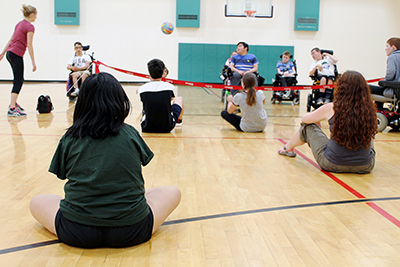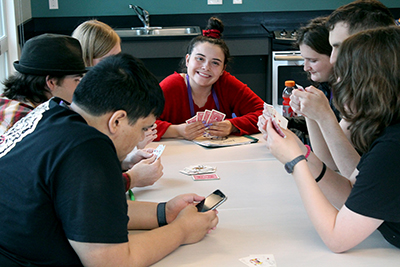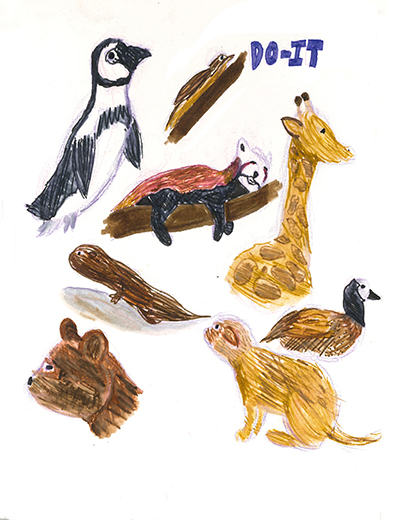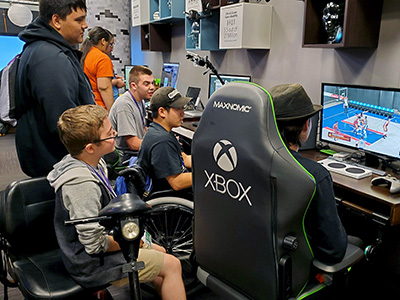Summer Study: What Do Phase I Scholars Do?
DO‑IT Phase I Scholars participate in a two-week, live-in Summer Study session on the UW Seattle campus. They learn about college life; explore online resources; interact with peers, staff, and mentors; and have fun. The DO‑IT Scholars program started in 1993 as an experimental project for teens with disabilities nationwide. It is currently open to Washington State teens and is supported by the State of Washington, and the Microsoft Corporation.
Adaptive Sports: An Opportunity Behind the Scenes

A basketball player goes for a layup. A soccer player spins past an opponent. Two rugby players collide, fighting for the ball. When you read these statements, do you imagine a game with players standing and running? What if I told you that I was describing adaptive sports? Would that influence how you saw the situation? Nearly one in five people in the US have a disability, yet disability sports are rarely televised and lack the prominence of their abled counterparts. If adaptive sports were featured more often, there would be a growth in acceptance for people with disabilities.
Generally defined, adaptive sports are sports that are modified to allow people with physical and sometimes mental disabilities to participate. Almost every sport, and many other athletic recreational activities, has an adaptive counterpart.
One common example is wheelchair soccer, also referred to as power soccer. It’s known as the first competitive power chair sport, and has an Official US Federation, competitive leagues, and even a World Cup. In January 2005, representatives from seven countries got together to form the International Powerchair Football Association (IPFA). Nowadays, over 250 teams compete under the IPFA banner. Power soccer is also officially listed in the Olympics. Wheelchair soccer follows most of the same rules as non-adaptive soccer. However, there are a few key differences. Power soccer is played on a basketball court with teams consisting of four players and the ball must be moved by a player’s chair, not their hands or feet. Team USA currently holds the Power Soccer World Championship.
Another popular example is wheelchair basketball. The rules of wheelchair basketball are very similar to those of non-adaptive basketball, with just a few changes around the methods for dribbling, traveling, and types of fouls. Wheelchair basketball also uses a different type of chair than people use day to day, which is designed to not fall over easily. Wheelchair basketball has a very passionate following—many Scholars in the DO-IT program have played the sport, including one of the authors of this article, Sam.
Despite the many sports available to persons with disabilities, many people do not know about them. These sports are relatively unknown outside of the disability community. Often people with disabilities can miss out on opportunities because these sports aren’t commonly in our media.
We want to make a call for action to more publicly support and acknowledge adaptive sports. Writers can feature these sports, activists and politicians can create change, and television networks can showcase games. Adaptive sports are not so different from the “norm,” so why shouldn’t they be just as featured? It will take a collective effort to surmount this issue, but perhaps, with a concerted push, we can give adaptive sports the prominence that they deserve.
If you have a disability and are interested in participating in an adaptive sport, look for local teams. In the Seattle area, check out Seattle Adaptive Sports.
Planetarium: Our Digital Trip Through the Universe
During the 2019 Summer Study DO-IT program, we had the unique experience of going to the UW planetarium. When we arrived, we were escorted to a large circular room with a long bench along the outside. The room was dimly lit and set the mood for exploring outer space. Several projectors around the room projected images on the domed ceiling, displaying the entire night sky.
In the presentation, we learned about our solar system and the individual planets within it. We even went beyond our solar system, and at the end of our presentation, we zoomed out to where we could get a view of the whole known universe. The technology enabled us to zoom through the sky and make it appear as though the stars were coming towards us. We even flew through Jupiter and saw all its moons. Our presenter was an astronomy student who was very passionate and great at making astronomy more accessible to the average person. Instead of using complex scientific words that we might not understand, he clearly explained each new term and welcomed any questions we had. One of the most interesting facts that we learned was that there may be different forms of life on planets or moons that do not require water to sustain them. The presenter explained that although scientists have a vast knowledge of outer space, they are far from knowing everything. He emphasized the importance of research and the continuous study of our galaxy.
This was one of our favorite sessions. The experience zooming through the stars and planets is unlike anything we have been able to experience, even in school. The visual sensation was like flying through space, and it felt like you were really there. We all came out of the planetarium more educated and informed about intergalactic sciences. Everyone was able to learn something, it was a comfortable learning atmosphere, and the technology paired with an engaging speaker made it a mind-blowing experience.
DO-IT: A Community Environment

In life there is no cavalry to save you when the treatment that you receive is different from everyone else, but a targeted mentoring program just might do the trick. DO-IT Scholars strive to become truly sensitive to the navigation of their disabilities as aspiring college students, but sometimes learning how to navigate each other is the most important aspect of success—with camaraderie, so much is possible.
Being a Phase I Scholar can be stressful, lonely, and confusing when you first arrive. You’re away from home with all new people, unsure of what’s to come. For a lot of us, this is the first time being away from our families, since most summer camps and programs either can’t handle our disabilities or think we are too much of a liability. Being with people, especially people you don’t know, all day, every day, can escalate anxieties.
All the staff and Interns try to make you feel included and welcome, but we all retain some level of anxiety, especially before getting to know the other Scholars. Often large group activities and icebreakers that are meant to allow people to get to know each other can have the opposite effect those of us with anxiety. It can be helpful to introduce yourself to people and show genuine interest to learn more about them.
We interviewed Intern Emma on how she became more comfortable and got involved when coming to DO-IT Summer Study.
Q: “How did you feel as a Phase I, awkward, excited, left out?”
A: “When I was a Phase I, I was really shy. I felt out of place. But once I started to get to know everyone else, I felt better… but it was also hard being away from home for the first time for two weeks.”
Q: “What was one thing that made a difference in making you feel like part of the group at DO-IT?”
A: “On the first day, my roommate Anna got up and said, ‘let’s introduce ourselves to the group.’ She pushed me to get out there and meet the others, making sure I didn’t just sit by myself.”
Q: “Do you feel more comfortable coming back as a Phase II Scholar or an Intern?”
A: “My Intern year, because now I’ve known the people in my group for two years. However, once I figured out what DO-IT really stood for and that they were here to help us succeed, I felt like I became a part of the community.”
Q: “Do you feel like DO-IT has helped you become your best self?”
A: “Yes, because I feel more comfortable with having my disability after going through this program because everybody is the same in the fact that they are different.”
Emma’s experience really showcases how just having someone to look out for you can really help you feel like part of a community. It is also really helpful to know that everybody feels nervous their first year; some people just show it more than others.
The Zoo

We visited the Woodland Park Zoo on Sunday, July 21. It was very hot out. We started our adventure at the south entrance and made our way up the main loop towards the tropical rainforest exhibits.
We first came across the ring-tail lemurs. They seemed to be sleeping, until after a few minutes they began to stir, groom, and stare at us from a shaded area atop a hill. In the exhibit next door, we saw red ruffed lemurs lazily lounging in the sun on some low hanging branches over a stream.
As we continued, we visited the den of the jaguar, who was prowling about and wondering around the enclosure. We also got to see the gorilla exhibit, where we saw one of the gorillas lying asleep. When we got to the gorilla’s exhibit, we were very surprised and sad to find out that the mountain gorilla is critically endangered; there are only around 1,000 mountain gorillas left in the wild. It was cool to see one in person at the zoo.
After we were done visiting with the gorillas, we passed by the penguin exhibit by the west entrance. There were also seagulls and a great crane hanging out. At this point, we had worked up an appetite and decided to grab lunch.
We enjoyed seeing all the animals about on a “lazy” Sunday, and overall liked our trip to the Woodland Park Zoo. This was a small insight into our trip to the Woodland Park Zoo.
National Park Accessibility
Although many of America’s National Parks have accessibility features for those with disabilities, the main National Park Service website leaves it up to each park to share their own accessibility information and has a mix of information on which parks are accessible, leaving it up to each park’s discretion on whether to include this information.
The main website directs you to find relevant information concerning accessibility on the “Plan Your Visit” feature of each individual park’s website. Some of the national park pages did not provide this critical information, while others gave the information in helpful detail. For example, the Great Smoky Mountains National Park in North Carolina and Tennessee had a whole page on accessibility, including detailed information on how to access the visitors center and camp/picnic grounds and information on park-wide facilities, including parking permits, amphitheaters, auto tours, camping, horse camps, and trails. While the sites that include this level of detail are great, not having the ability to quickly search which National Parks are accessible by using the “Find a Park” feature on the main website adds an additional barrier for people with disabilities. Every park page should contain detailed information about accessibility to ensure equal rights and access.
We also learned about the “Access Passport” permit, which allows free entry into the park. In order to obtain this, go to a local ranger station and bring some form of ID along with diagnostic documentation from a physician. Any US citizen with a permanent disability may obtain one. For more information about the Access Pass, see About the Access Pass (in PDF) from the U.S. Fish & Wildlife Service.
Microsoft Trip

On the first Friday of Summer Study, we took a trip to the Microsoft campus and participated in some engaging activities. First, DO-IT Scholars split into small groups to design a robotic dog that could aid people with disabilities. One common idea was that the dog could detect objects and sounds nearby and notify its owner in various ways. This activity simulated how an innovative company like Microsoft creates and designs new products.
After that, we had a presentation about Microsoft and how its products have accessibility tools to help people with disabilities. Next, we listened and asked questions to a panel with Microsoft employees who have a disability. A few of them have been a part of the DO-IT program. They discussed what designers, engineers, and program managers do as a team and explained their journeys and struggles and how Microsoft has helped them continue their work.
For lunch, Microsoft provided us with a taco bar, which was really nice. We were treated like employees for the day and had many drink options available. It is definitely a great perk of working at Microsoft.
After lunch, our group headed across campus to the Xbox Inclusive Tech Lab. The goal of the lab is to make sure everyone can play games. We learned and talked about the Xbox Adaptive Controller, which is for people who have difficulty playing with a normal controller. Bryce, who works at the lab, showed us some videos of people using the Xbox Adaptive Controller to show how it can help someone with a disability that makes it hard to hold a regular game controller. A regular Xbox controller can pair up with one of the adaptive controllers to work as one whole controller. The adaptive controller also can connect to many different customizable switches. We listened to a 3D surround sound system, which helps people who are deaf or hard of hearing. It brings a whole new level to movies, TV, and music. After the presentation, everyone was allowed to play video games on Xbox consoles and PCs using many types of controllers. We chose to play Minecraft on the PC, which was fun. Other Scholars chose to play different games, such as soccer and other sports. We had a great experience at Microsoft.
Working with Phase I Scholars in the Classroom
This year at Summer Study we got to help the Phase I Scholars in the classroom, where they would work on projects, participate in sessions, and practice using their assistive technology during the day. We ensured that classes ran smoothly by answering questions and helping the Scholars complete their website.
We learned that as Interns, we had to be patient when working with the Scholars. Sometimes we would have to explain something in multiple ways or repeatedly keep people on track with their work. We also jumped in to help where we could. Towards the end of the second week we also helped with their written projects by being interviewed and brainstorming.
Our favorite parts were getting to know the Scholars, helping teach, and seeing them learn. It was different going through the classes as observers. Our internship gave us a deeper understanding of the activities during Summer Study.